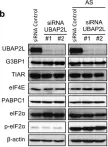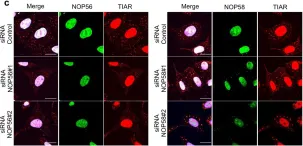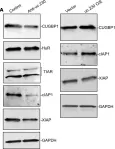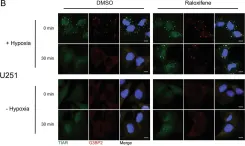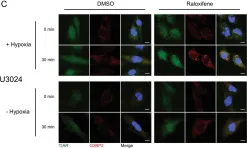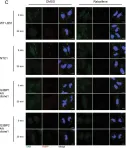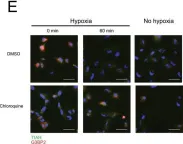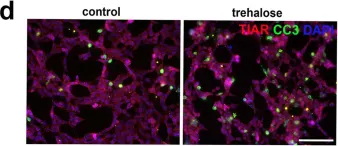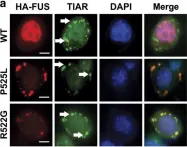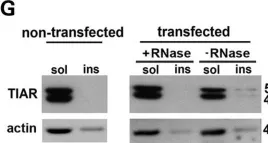Lately, important advancements in visualizing RNAs in fixed and live cells have been achieved. Although mRNA imaging techniques are well-established, the development of effective methods for studying noncoding RNAs (ncRNAs) in living cells is still challenging but necessary, as they show a variety of functions and intracellular localizations, including participation in highly dynamic processes like phase transition, which is still poorly studied in vivo. Addressing this issue, we tagged two exemplary ncRNAs with the fluorescent RNA (fRNA) Pepper. Specifically, we showed that circ-HDGFRP3 interacts with p-bodies and is recruited in pathological FUS aggregates in a dynamic fashion, and we super-resolved its distribution in such condensates via structured illumination microscopy. Moreover, we tracked the long noncoding RNA (lncRNA) nHOTAIRM1, a motor neuron-specific constituent of stress granules, monitoring its behavior throughout the oxidative-stress response in physiological and pathological conditions. Overall, as fRNA development progresses, our work demonstrates an effective use of Pepper for monitoring complex processes, such as phase transition, in living cells through the visualization of circular RNAs (circRNAs) and lncRNAs with super-resolution power.
© 2025 Vitiello et al.; Published by Cold Spring Harbor Laboratory Press for the RNA Society.
Product Citations: 62
In RNA on 18 March 2025 by Vitiello, E., Castagnetti, F., et al.
-
Genetics
In Communications Biology on 2 January 2025 by Kim, K. M., Girdhar, A., et al.
Arginine-rich dipeptide repeat proteins (R-DPRs) are highly toxic proteins found in patients with C9orf72-linked amyotrophic lateral sclerosis and frontotemporal dementia (C9-ALS/FTD). R-DPRs can cause toxicity by disrupting the natural phase behavior of RNA-binding proteins (RBPs). Mitigating this abnormal phase behavior is, therefore, crucial to reduce R-DPR-induced toxicity. Here, we use FUS as a model RBP to investigate the mechanism of R-DPR-induced aberrant RBP phase transition. We find that this phase transition can be mitigated by Kapβ2. However, as a nuclear import receptor and phase modifier for PY-NLS-containing RBPs, the function of WT Kapβ2 could lead to undesired interaction with its native substrates when used as therapeutics for C9-ALS/FTD. To address this issue, it is crucial to devise effective strategies that allow Kapβ2 to selectively target its binding to the R-DPRs, instead of the RBPs. We show that NLS-binding deficient Kapβ2W460A:W730A can indeed selectively interact with R-DPRs in FUS assembly without affecting normal FUS phase separation. Importantly, Kapβ2W460A:W730A prevents enrichment of poly(GR) in stress granules and mitigates R-DPR neurotoxicity. Thus, NLS-binding deficient Kapβ2 may be implemented as a potential therapeutic for C9-ALS/FTD.
© 2025. The Author(s).
-
In Vitro
-
Rattus norvegicus (Rat)
ALS-associated FUS mutation reshapes the RNA and protein composition of stress granules.
In Nucleic Acids Research on 27 November 2024 by Mariani, D., Setti, A., et al.
Stress granules (SG) are part of a cellular protection mechanism where untranslated messenger RNAs and RNA-binding proteins are stored upon conditions of cellular stress. Compositional variations due to qualitative or quantitative protein changes can disrupt their functionality and alter their structure. This is the case of different forms of amyotrophic lateral sclerosis (ALS) where a causative link has been proposed between the cytoplasmic de-localization of mutant proteins, such as FUS (Fused in Sarcoma), and the formation of cytotoxic inclusions. Here, we describe the SG transcriptome in neuroblastoma cells and define several features for RNA recruitment in these condensates. We demonstrate that SG dynamics and RNA content are strongly modified by the incorporation of mutant FUS, switching to a more unstructured, AU-rich SG transcriptome. Moreover, we show that mutant FUS, together with its protein interactors and their target RNAs, are responsible for the reshaping of the mutant SG transcriptome with alterations that can be linked to neurodegeneration. Our data describe the molecular differences between physiological and pathological SG in ALS-FUS conditions, showing how FUS mutations impact the RNA and protein composition of these condensates.
© The Author(s) 2024. Published by Oxford University Press on behalf of Nucleic Acids Research.
-
Biochemistry and Molecular biology
-
Genetics
In Nature Communications on 26 June 2024 by Wang, C., Tanizawa, H., et al.
METTL3 is the catalytic subunit of the methyltransferase complex, which mediates m6A modification to regulate gene expression. In addition, METTL3 regulates transcription in an enzymatic activity-independent manner by driving changes in high-order chromatin structure. However, how these functions of the methyltransferase complex are coordinated remains unknown. Here we show that the methyltransferase complex coordinates its enzymatic activity-dependent and independent functions to regulate cellular senescence, a state of stable cell growth arrest. Specifically, METTL3-mediated chromatin loops induce Hexokinase 2 expression through the three-dimensional chromatin organization during senescence. Elevated Hexokinase 2 expression subsequently promotes liquid-liquid phase separation, manifesting as stress granule phase separation, by driving metabolic reprogramming. This correlates with an impairment of translation of cell-cycle related mRNAs harboring polymethylated m6A sites. In summary, our results report a coordination of m6A-dependent and -independent function of the methyltransferase complex in regulating senescence through phase separation driven by metabolic reprogramming.
© 2024. The Author(s).
-
Biochemistry and Molecular biology
-
Cell Biology
Preprint on BioRxiv : the Preprint Server for Biology on 3 June 2024 by Vitiello, E., Castagnetti, F., et al.
ABSTRACT Lately, important advancements in visualizing RNAs in fixed and live cells have been achieved. While mRNA imaging techniques are well-established, the development of effective methods for studying non-coding RNAs (ncRNAs) in living cells are still challenging but necessary, as they cover a variety of function and of intracellular localization, including highly dynamic processes like phase-transition, still poorly studied in vivo . Addressing this issue, we tagged two exemplary ncRNAs with the innovative fluorescent RNA (fRNA) Pepper. Specifically, we show circ-HDGFRP3 interaction with p-bodies, we recapitulate its recruitment in pathological FUS aggregates in a dynamic fashion and we super-resolve its distribution in such aggregates via Structured Illumination Microscopy. Moreover, we tracked the long non-coding RNA (lncRNA) nHOTAIRM1, a motor neurons-specific constituent of stress granules (SG), monitoring its behavior throughout the oxidative-stress response in physiological and pathological conditions. Overall, as fRNAs development advances, our work shows a successful use of Pepper for the monitoring of complex processes, as phase-transition, of paradigmatic molecules like circular RNAs (circRNAs) and lncRNAs with super-resolution potential in living mammalian cells.
-
Genetics
In Commun Biol on 14 April 2023 by Asano-Inami, E., Yokoi, A., et al.
Fig.2.B

-
WB
-
Homo sapiens (Human)
Collected and cropped from Commun Biol by CiteAb, provided under a CC-BY license
Image 1 of 10
In Commun Biol on 14 April 2023 by Asano-Inami, E., Yokoi, A., et al.
Fig.6.C

-
ICC-IF
-
Homo sapiens (Human)
Collected and cropped from Commun Biol by CiteAb, provided under a CC-BY license
Image 1 of 10
In JCI Insight on 10 October 2022 by Yu, T. X., Kalakonda, S., et al.
Fig.8.A

-
WB
-
Collected and cropped from JCI Insight by CiteAb, provided under a CC-BY license
Image 1 of 10
In Cell Death Dis on 17 November 2020 by Attwood, K. M., Robichaud, A., et al.
Fig.3.B

-
IF
-
Homo sapiens (Human)
Collected and cropped from Cell Death Dis by CiteAb, provided under a CC-BY license
Image 1 of 10
In Cell Death Dis on 17 November 2020 by Attwood, K. M., Robichaud, A., et al.
Fig.3.C

-
IF
-
Homo sapiens (Human)
Collected and cropped from Cell Death Dis by CiteAb, provided under a CC-BY license
Image 1 of 10
In Cell Death Dis on 17 November 2020 by Attwood, K. M., Robichaud, A., et al.
Fig.8.C

-
IF
-
Homo sapiens (Human)
Collected and cropped from Cell Death Dis by CiteAb, provided under a CC-BY license
Image 1 of 10
In Cell Death Dis on 17 November 2020 by Attwood, K. M., Robichaud, A., et al.
Fig.7.E

-
IF
-
Homo sapiens (Human)
Collected and cropped from Cell Death Dis by CiteAb, provided under a CC-BY license
Image 1 of 10
In Sci Rep on 9 March 2017 by Dimasi, P., Quintiero, A., et al.
Fig.6.D

-
IHC-IF
-
Homo sapiens (Human)
Collected and cropped from Sci Rep by CiteAb, provided under a CC-BY license
Image 1 of 10
In Cell Death Discov on 1 January 2015 by Soo, K. Y., Sultana, J., et al.
Fig.7.A

-
ICC-IF
-
Mus musculus (House mouse)
Collected and cropped from Cell Death Discov by CiteAb, provided under a CC-BY license
Image 1 of 10
In Hum Mol Genet on 1 October 2014 by Shelkovnikova, T. A., Robinson, H. K., et al.
Fig.2.G

-
WB
-
Collected and cropped from Hum Mol Genet by CiteAb, provided under a CC-BY license
Image 1 of 10
